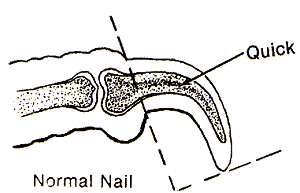The following information was taken from the The International Cockatiel Association web site. It is extremely useful and important information about clipping bird wings and nails.
Though they specify cockatiels in this article, the procedure pertains to all birds. And, as stated many times throughout this site, wing clipping is important to ensure the safety of your pet bird, especially if they are allowed to roam freely about your home.
Clipping Cockatiel Wings, Nails and Beaks
Written by Nancy Kizuka for the NCS Magazine, © 1997 by NCS
Clipping Wings
Nothing is more beautiful than watching your cockatiel fly. Nothing is
more heartbreaking than watching it fly outside.
I hope that most of us clip wings. I know that some do not. It doesn't
hurt, nor is it cruel. I feel it is more cruel for a predator to end up with
a 'tiel snack.
I do however, let my babies (of all species) learn to fly and land safely.
Once they have mastered that, their wings are clipped. Now, before
you show members start getting the feathers raised, remember, we
are talking about pet cockatiels.
I prefer to clip evenly on both sides; that way the bird can control its descent. Try clipping the first 5 flight feathers. You don't want the bird to drop - just glide gently to the floor. Continue one feather at a time, until the bird cannot gain altitude.
Your bird will need to be clipped again after the next molt. Be careful, sometimes those feathers can sneak up on you. All it takes is 1 feather on each wing for a cockatiel to be able to fly.
When clipping these flight feathers, be careful not to clip any growing feathers. You will recognize these blood feathers from the others since you can see the dark blood area in the shaft.
If you are not quiet sure you can be your bird's barber, contact your avian veterinarian or local pet shop. Most will do this grooming for you for a nominal charge. Many will give you hands-on experience.
Clipping Nails
Nails need to be clipped when they are uncomfortable on your skin. I use a
human nail clipper or baby nail scissors, and take off just the tips.
All nails have a blood supply. If you nick into this blood supply or quick, have
some Quik-Stop or Stay on hand. If you do not have these commercial products
on hand, flour or corn starch will work. Apply this with gentle pressure until the
bleeding stops. Occasionally the nail gets cut too short and these products don't
work. I like to use silver nitrate sticks to stop any bleeding. They are available
from your avian veterinarian.
The proper size perch can help keep nails at the correct length. The tips of the nails should touch the perch. You can also use a new concrete perch. Using many different size perches also helps the bird stay comfortable since they are on their feet 24 hours a day, 7 days a week.
Keeping Beaks Trimmed
Beaks usually do not need to be trimmed. I have only one cockatiel who's beak is trimmed on a regular basis. She is an older bird with liver disease. Her upper beak gets trimmed every other week or so.
Keeping a mineral block or small bird lava stone in the cage will assist in keeping the cockatiel's beak at the proper size and shape. Toys and safe objects to chew on also help with this and prevent boredom.
If you think your bird's beak may need to be trimmed, please check with your avian veterinarian. I'm sure they will be happy to do this for you and teach you how to keep your bird's beak in shape.
Information Source: The International Cockatiel Association

